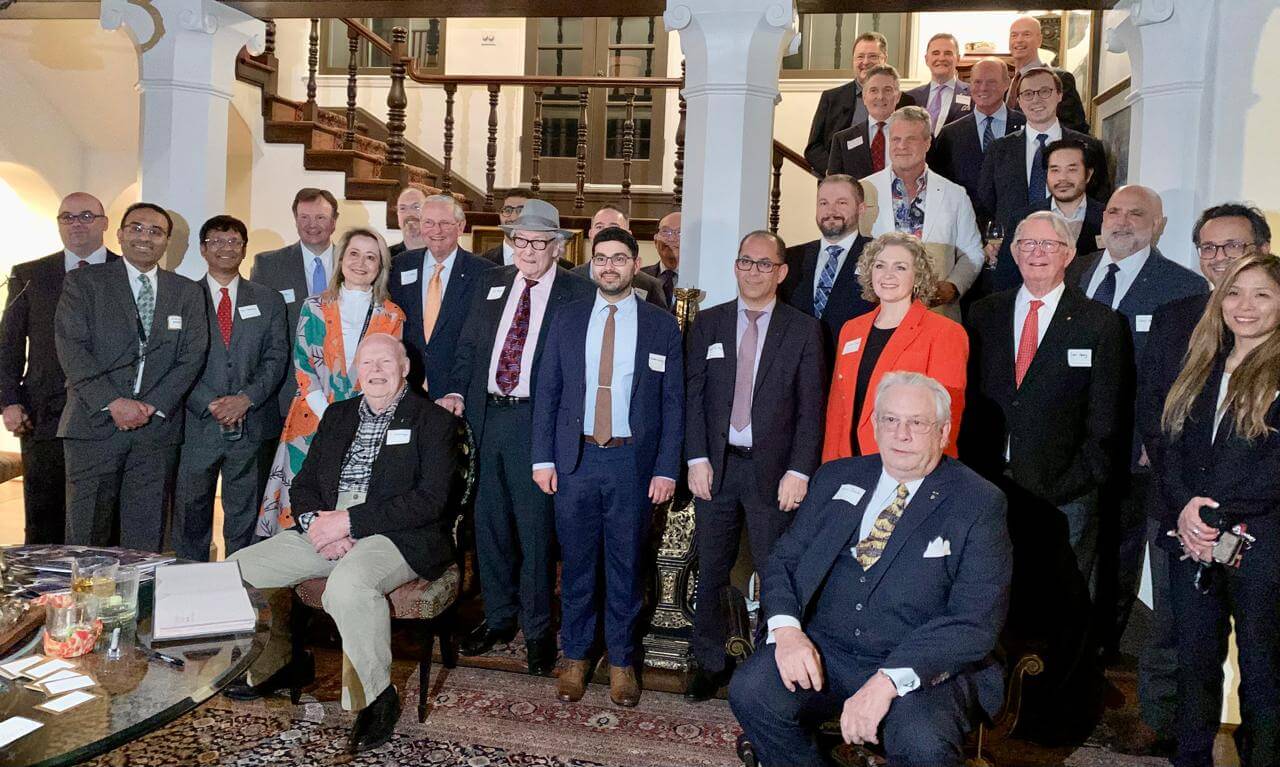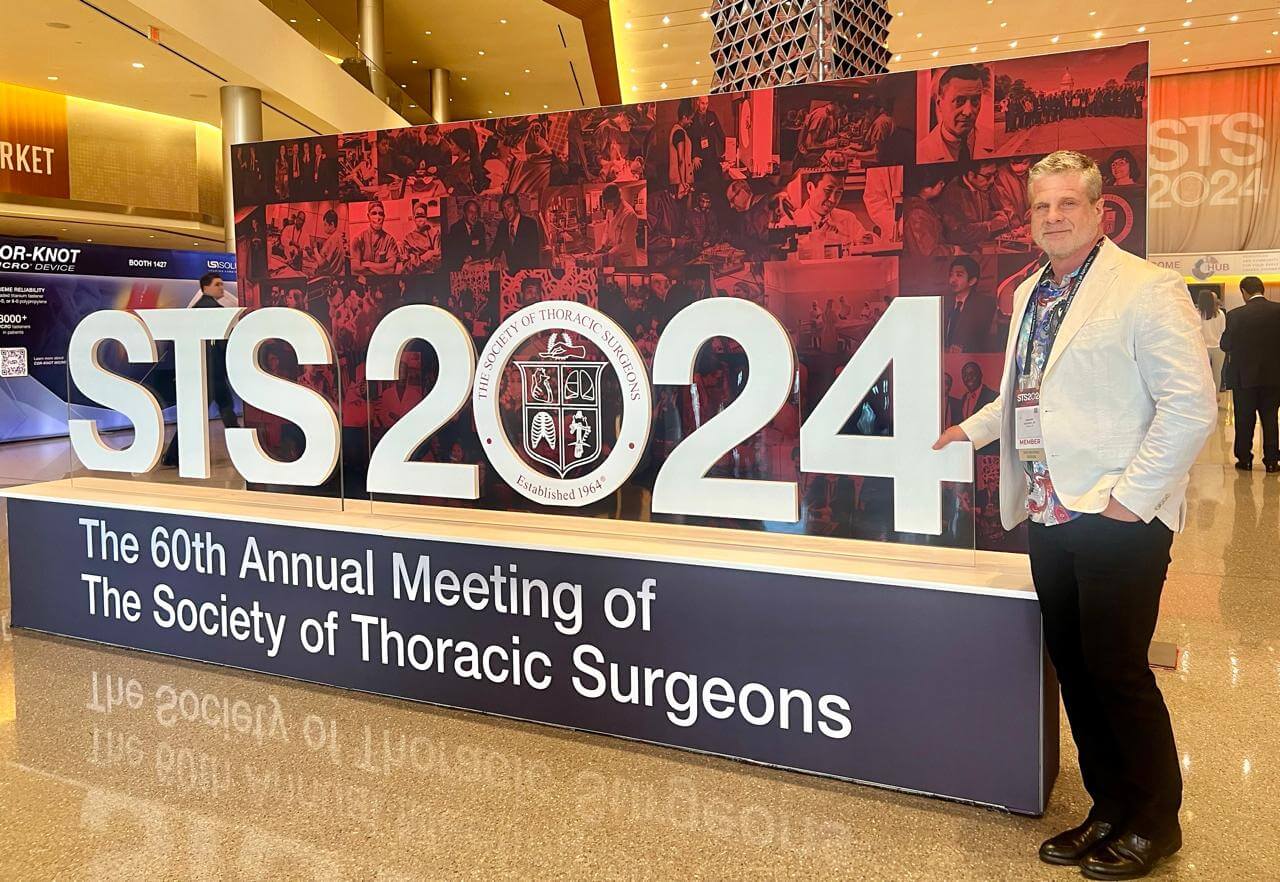Keywords: Pseudoaneurysm of the ascending aorta is a rare but severe complication of cardiac surgery. Most cases occur after coronary artery bypass grafting (CABG) and aortic valvular procedures, and many others occur after cardiac transplantation. Thus far, the only reported case of a pseudoaneurysm related to a left ventricular assist device (LVAD) is a pseudoaneurysm related to the prosthetic graft itself.
Clinical summary
Figure 1 Surface-shaded rendering of the thoracic aorta in the lateral projection superimposed on a single sagittal slice of the chest, as acquired by means of 3-dimensional MRA. The arrowheads denote the sternum and show the proximity of the pseudoaneurysm (arrow) when considering re-exploration. The twisting line between the pseudoaneurysm and the sternum indicates the right internal thoracic artery.
At 1 year of follow-up, the patient was stable with no neurologic deficits. A CT scan of the chest showed normal findings and confirmed that the Dacron patch repair was still intact (Figure 2). The antibiotic regimen was discontinued on the recommendation of an infectious disease consultant.
Discussion
References
- Knosalla C.
- Weng Y.
- Buz S.
- Loebe M.
- Hetzer R.
Pseudoaneurysm of the outflow graft in a patient with Novacor N100 LVAS system.Ann Thorac Surg. 2000; 70: 1594-1596- Frazier O.H.
Mechanical cardiac assistance.Semin Thorac Cardiovasc Surg. 2000; 12: 207-220- Frazier O.H.
Future direction of cardiac assistance.Semin Thorac Cardiovasc Surg. 2000; 12: 251-258- Frazier O.H.
- Benedict C.R.
- Radovancevic B.
- Bick R.J.
- Capek P.
- Springer W.E.
- et al.
Improved left ventricular function after chronic left ventricular unloading.Ann Thorac Surg. 1996; 62: 675-682- Hetzer R.
- Muller J.H.
- Weng Y.
- Meyer R.
- Dandel M.
Bridging-to-recovery.Ann Thorac Surg. 2001; 71: S109-113- Sullivan K.L.
- Steiner R.M.
- Smullens S.N.
- Griska L.
- Meister S.G.
Pseudoaneurysm of the ascending aorta following cardiac surgery.Chest. 1988; 92: 138-143- Razzouk A.
- Gundry S.
- Wang N.
- Heyner R.
- Sciolaro C.
- Van Arsdell G.
- et al.
Pseudoaneurysms of the aorta after cardiac surgery of chest trauma.Am Surg. 1993; 59: 818-823- Katsumata T.
- Moorjani N.
- Vaccari G.
- Westaby S.
Mediastinal false aneurysm after thoracic aortic surgery.Ann Thorac Surg. 2000; 70: 547-552- Marx M.
- Gardiner G.A.
- Miller R.H.
The truth about false aneurysm.Am J Radiol. 1985; 145: 193-194- Jacobs M.J.
- Reul G.J.
- Gregoric I.
- Cooley D.A.
In-situ replacement and extra-anatomic bypass for the treatment of infected abdominal grafts.Eur J Vasc Surg. 1991; 5: 83-86
Article Info
Publication History
Identification
Copyright
ScienceDirect
Access this article on ScienceDirectLearn about prosthetic graft remnant-related pseudoaneurysm, a rare vascular complication where a false aneurysm forms at the site of a previous graft, requiring timely diagnosis and intervention.
Párrafo de 300 palabras:
A prosthetic graft remnant-related pseudoaneurysm is a rare but serious complication that can occur after vascular surgery where a prosthetic graft has been used to repair damaged blood vessels. This condition involves the formation of a false aneurysm at the site where the graft material meets the native blood vessel, due to incomplete healing or weakening of the vessel wall. The pseudoaneurysm is not a true aneurysm, as it does not involve all layers of the blood vessel wall but is instead a collection of blood outside the vessel, contained only by the surrounding tissue.
The development of a prosthetic graft remnant-related pseudoaneurysm can occur months or even years after the initial surgery. Common symptoms may include localized swelling, pain, or pulsation at the graft site, though in some cases, the condition may be asymptomatic and discovered incidentally during imaging studies. If left untreated, the pseudoaneurysm can rupture, leading to life-threatening hemorrhage.
The diagnosis of prosthetic graft remnant-related pseudoaneurysm typically involves imaging techniques such as ultrasound, CT scan, or MRI, which can visualize the abnormal blood collection and assess the size and risk of rupture. Early detection is crucial for preventing severe complications.
Treatment options for prosthetic graft remnant-related pseudoaneurysm depend on the size, location, and risk of rupture. In some cases, observation and monitoring are sufficient, especially for smaller or asymptomatic pseudoaneurysms. However, larger or symptomatic pseudoaneurysms often require surgical intervention, such as repair of the graft or embolization, to prevent rupture and restore normal blood flow.
Overall, a prosthetic graft remnant-related pseudoaneurysm is a serious vascular complication that requires prompt diagnosis and treatment to prevent severe consequences. Regular follow-up and imaging are essential for patients who have undergone vascular surgeries involving prosthetic grafts.






